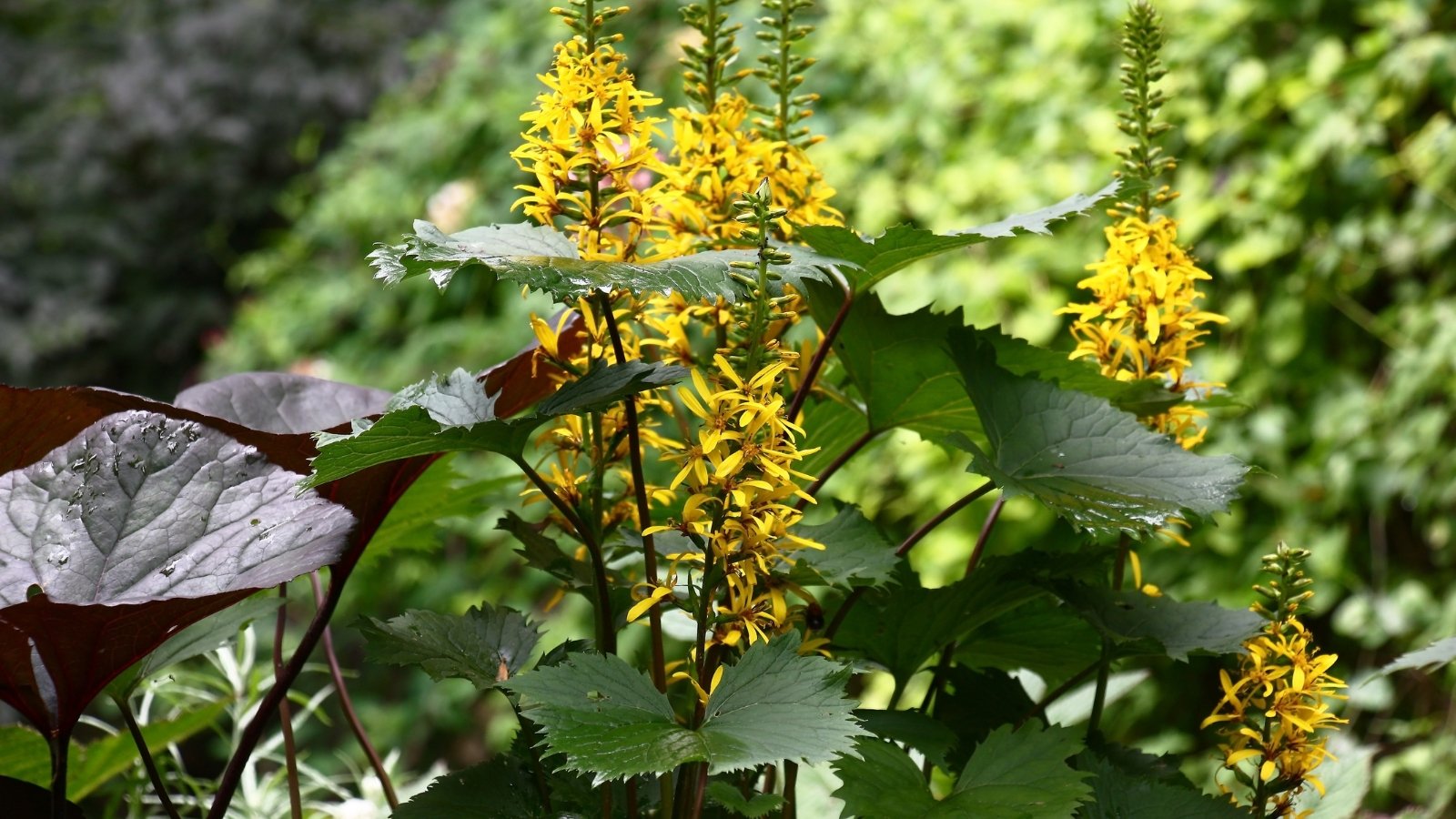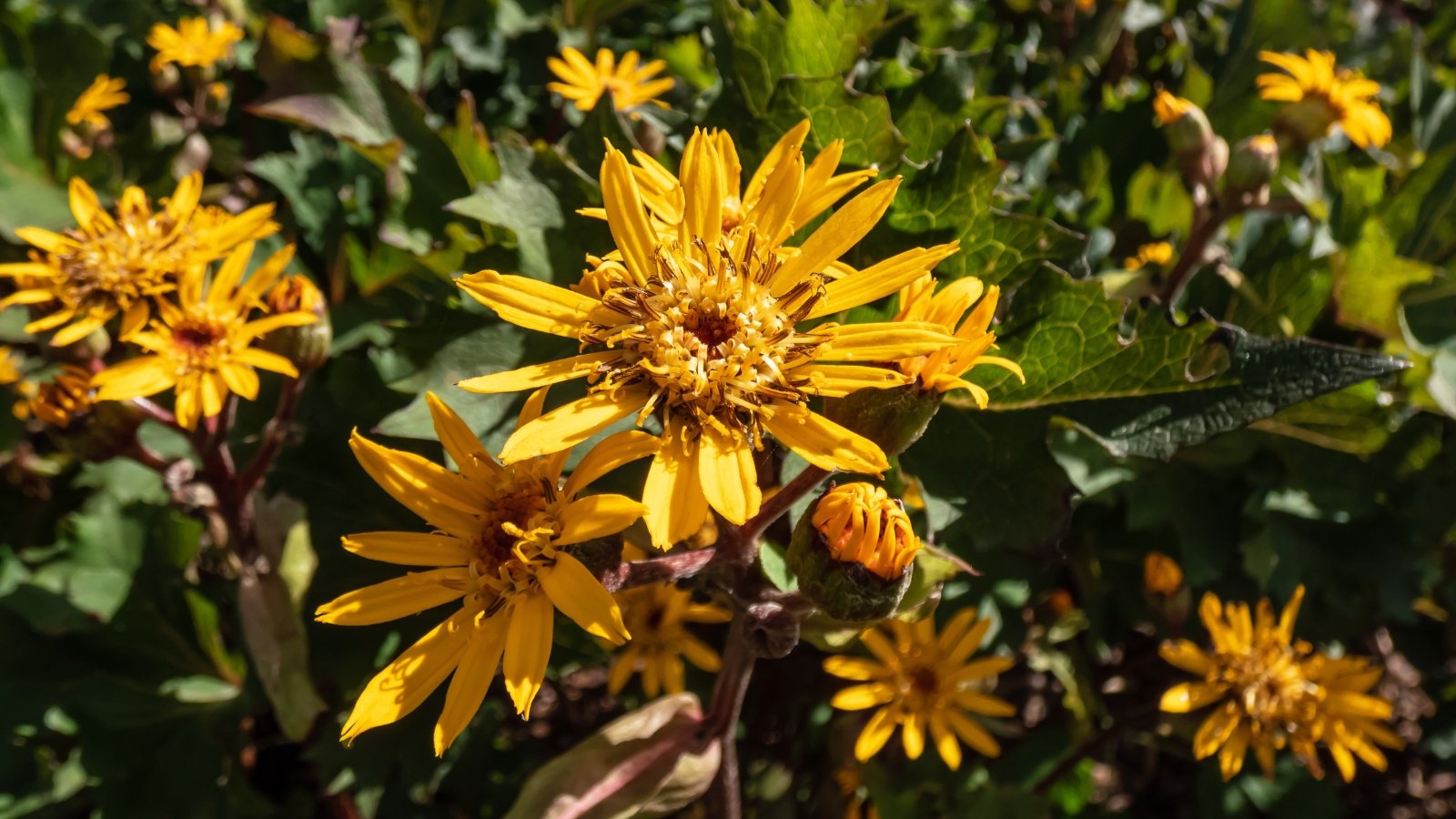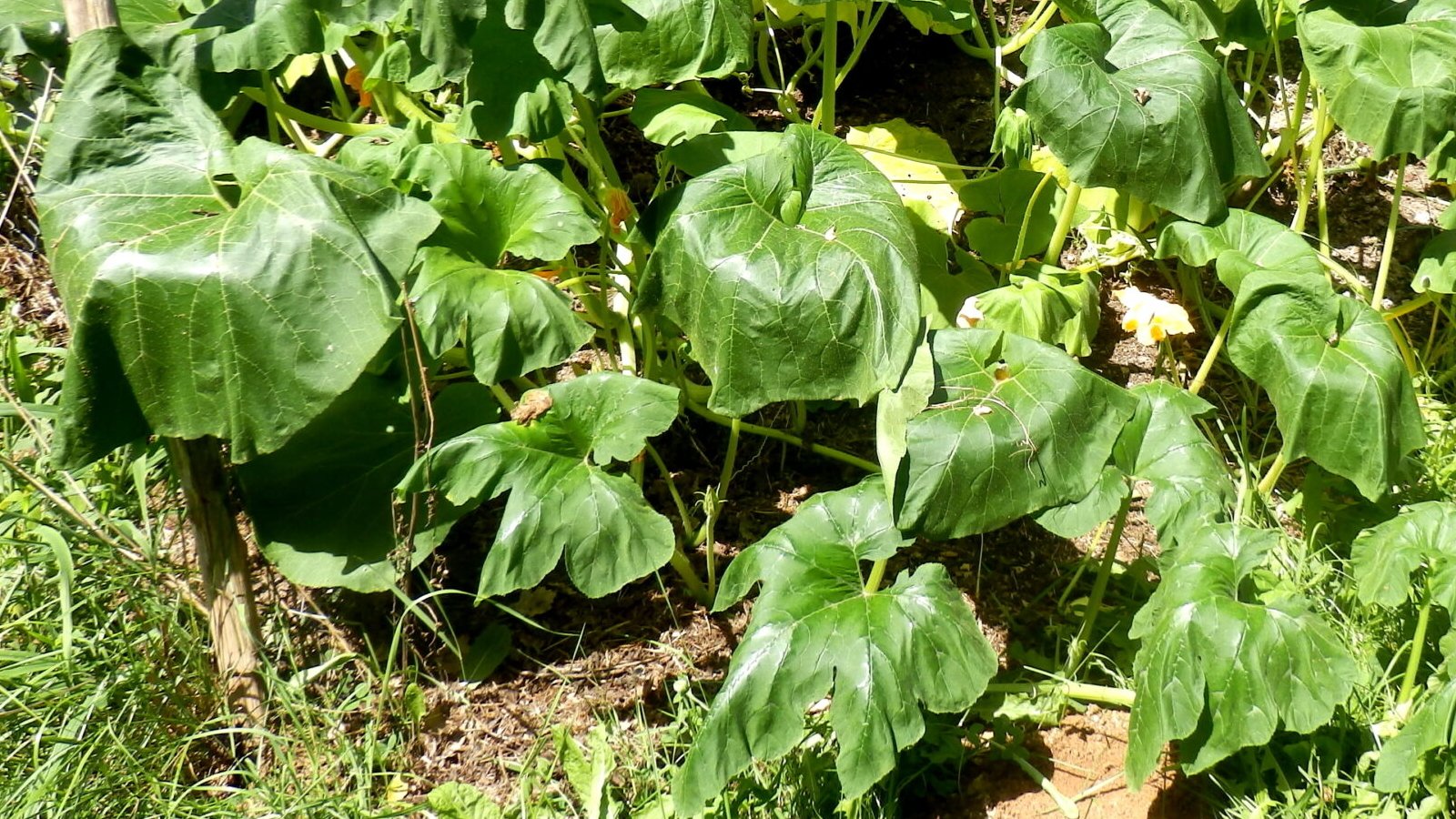Finding flowering plants for shaded areas in the landscape can be difficult. Ligularia is a great option for these spots. It’s a wonderful floriferous semi-evergreen. Also known as the leopard plant, it’s easy to grow and care for.
This member of the aster family makes an imposing figure in your beds. It flowers wonderfully, attracting a wide array of pollinators. Its fall blooming season makes it a great food source for those pollinators getting ready for the winter dearth.
Let’s look at this wonderful shade lover with the striking flower spikes and statement-making foliage. It is delightfully easy to grow and has a lot to offer.
Ligularia Overview

|
|
|
|
What Is It?


Ligularia is a beautiful plant related to sunflowers. It surprises me that it isn’t more popular and well-known. This plant has so many wonderful qualities. From its pest resistance to its ability to thrive and flower in more shaded areas, this is a winner in my book.
Characteristics


Ligularia forms a basal rosette of large, glossy leaves that often are green on top and purple underneath. The leaves can be triangular, kidney, or heart-shaped, and sometimes have toothy edges. The grand foliage makes a statement and is evergreen in milder climates.
In the fall, this plant will send up tall flower spikes. The flowers are warm shades of yellow and orange and grow in a flat-topped cluster or cone-shaped spike. Their blooming season can last several months and the flowers are a great source of nectar and pollen.
Native Area


Asia is home to this flowering stunner. It’s mainly found in China, Japan, and Siberia. It often grows near water features and under the cool, woodland canopy. It requires moist, rich soil and some shade, so it naturally grows in areas with these conditions. In Japan, the plant is called Metakaraku. This nickname means ‘sweet-smelling roots’.
Planting


Planting can take place in spring or fall, with each having specific benefits. When planted in spring, your ligularia will have ample time to grow during summer. If you prefer to plant in the fall, it will spend energy over the winter developing a strong root system.
Choose a spot with partial to full shade and dig a hole that is slightly larger than the root ball. The hole should allow the root ball to sit below the level of the surrounding soil by about a half inch.
Place the root ball in the hole and backfill it with soil. Water your ligularia deeply and cover the soil surface with mulch. Mulch is especially important if you’re planting in the fall, as it will protect your new plant from cold.
Growing from Seed


You can grow ligularia from seeds, but they tend to have an unreliable germination rate. The seeds take up to 42 days to germinate, so don’t get discouraged if it feels like it’s taking a long time. They germinate best between 55-65°F (13-18°C).
These seeds need light to germinate, so surface sow them on moist potting or starting mix. Lightly press into the soil with your finger, but don’t cover them. Cover your seed trays with plastic wrap, and set them in a cool but light spot.
Make sure to keep these seeds moist while they are sprouting and first developing. They are moisture lovers. Don’t place your seedlings in direct sun, but make sure there is some indirect light.
How to Grow


Ligularia is generally easy to grow. It has few enemies in the garden, aside from slugs and Japanese beetles. Plants grow easily as long as they have some shelter from the sun and enough moisture. Balance is the name of the game for this semi-evergreen.
Light


This one will grow in almost complete shade, but it needs some light to bloom to its full potential, so partial shade or bright filtered light is ideal. In full sun, the leaves will wilt, and the flowers will not last nearly as long. Adding shade-tolerant species can help transform your shaded yard into a zen oasis like the landscape in this video:
If you have the option, a great spot to plant it is in partial shade, with sun early in the day and shade in the afternoon. The sun is hotter and more intense in the afternoon and will cause ligularia to wilt. The more sun your plant receives, the more water it will need.
Water


This is a moisture lover, so it may need some extra attention in this department. If your ligularia is in a container, you will need to water it often, every day to every other day, depending on the season. In the ground, the soil should stay consistently moist.
Water your newly planted ligularia at least twice weekly. Water deeply as these form deep root systems. The roots of most species are sensitive to drought, so it’s important to water deeply.
If you can, plant it near a water feature. It will grow wonderfully next to a stream or pond. Expect that you will have to water this one at least once a week, even after it establishes. They are fast growers when you meet their needs. They will also let you know when they are thirsty by wilting.
Soil


Rich, loamy, fertile, and moist is the ideal soil type for this plant. A slightly acidic to neutral pH is preferable for optimal nutrient uptake. After choosing a location, if your soil is poor or sandy, work in a heavy helping of organic compost or manure.
Temperature and Humidity


This plant has excellent cold tolerance. The roots can survive low temperatures, and with some protection, they will survive Zone 3 winters. If temperatures drop below 30°F (-1°C) the foliage will suffer and ultimately die back. It can be evergreen in climates that don’t experience a hard frost.
The optimal growth temperature is between 60-75°F (16-24°C). It does most of its growing in spring and fall when it’s cooler outside. In temperatures above 75°F (24°C), make sure it gets plenty of water. In the afternoon sun, it will suffer during the warmer months.
Ligularia prefers a humid environment. In the absence of higher humidity, sufficient watering is a must. Moisture and temperature are the most important factors in keeping it happy.
Fertilizing


These don’t need an excessive amount of fertilizer, especially in rich soil. They are efficient at utilizing nutrients in the soil. A spring application of a slow-release fertilizer or compost should be sufficient.
Too much nitrogen can cause excessive foliage growth. That usually equates to fewer and less robust flowering.
Maintenance


In late fall, after the foliage dies back from frost, you can cut it back to the ground. You can also leave the dead foliage attached until spring as added winter protection. Then, cut to the ground in spring for bushier growth. Deadheading will encourage more and stronger flowers.
Propagation


Propagate ligularia by division for the best results. You may want to do this every two to three years, regardless of whether you want to move them. Thin out your plants to give them space for rooting and keep them from crowding one another.
Just as with initial planting, division is best done in early spring, or late summer to early fall. Divided in the spring, your plants will spend the season growing during the warm seasons. Those divided in the fall will enjoy a dormancy while their roots get established.
Water your plant well the day before digging it up. Make sure to choose a cool or cloudy day for this project. The heat stresses these plants. Try to dig up as much of the roots as possible. They have deep roots, so dig down deeper than you think.
Use your hands to work the soil away from the root ball. Look for places where there are natural divisions for the ideal spots to separate the roots. If you work the roots gently with your hands, it should be easy to see where they naturally separate.
Use a knife to cut through the root crown. Make sure that each division has some roots and some shoots. Plant your divisions in the same manner as the original parent.
Popular Varieties
Several beautiful cultivars can help spice up your shady spaces.
‘Othello’


You’ll love this variety for its foliage as much as its flowers. The leaves are deep purple beneath and dark, greenish-brown on top. They are heart-shaped and dramatic, so this variety is enjoyable throughout the growing season.
In late summer, ‘Othello’ sends up tall, red stems which support large clusters of flowers. The blooms are deep yellow and daisy-like. The blooms are large, up to four inches in diameter.
‘Midnight Lady’


Large, rounded leaves make up the foundation of this variety. Ligularia plants have a tropical appearance, despite their cold hardiness. The leaves are green on top and deep purple beneath, with purple veining.
‘Midnight Lady’ is a midsummer bloomer. The flower stems can be up to four feet tall and support clusters of large, orange, daisy-like flowers. The flowers are great for cutting, and the foliage is eye-catching.
‘Brit-Marie-Crawford’


Deep purple leaves make ‘Brit-Marie-Crawford’ a standout in the shade garden. Dark and brooding for most of the season, this one belongs in a goth garden. The leaves are toothy and heart-shaped.
In midsummer, tall reddish-purple stems shoot skyward. The flowers are large, and daisy-like, in a deep yellow to orange shade. The variety was first discovered by a gardener named Brit-Marie-Crawford in her patch of ‘Othello’ ligularia in Scotland.
‘The Rocket’


This is a special variety that won the Award of Garden Merit from the Royal Horticultural Society. It’s a large variety with very tall flower stems that can grow up to five feet. The towering stems carry large cone-shaped flower clusters in bright yellow.
‘The Rocket’ has large, heart-shaped, very toothy foliage. It lacks the purple of many varieties in favor of a brighter shade of green. The stems, however, are very deep purple, creating a striking contrast with the brilliant flowers.
Common Problems


For the most part, this plant is unproblematic. Most issues will arise from under-watering or too much sun exposure.
Pests


Slugs and snails are the most likely garden pests to come for your leopard plants, along with Japanese beetles. If you start to see holes in your leaves, they are the likeliest culprits. These pests like moist soil and the cool shade that ligularia also prefer.
Sprinkle diatomaceous earth around your plants, or use beer traps as a pollinator-safe way to get rid of slugs and snails. Copper tape is also effective in warding them off.
Hand-pick Japanese beetles as you see them. If they’ve been an issue in an area before, you can use beneficial nematodes to eliminate their larvae that overwinter in the soil. Apply two treatments two weeks apart in temperate spring weather. Then, plant your transplants.
Diseases


The diseases associated with this plant are predominantly fungal. Because of the high moisture needs, you could see powdery mildew pop up on those pretty leaves.
Poorly draining soil can also lead to root rot. This may cause your plant to look droopy and wilted despite watering and proper sun exposure. A foul smell at the soil level is also not uncommon.
Make sure your soil drains properly, and when you water, direct the water to the soil, not to the foliage. Maintain good air circulation around your plant to help keep those leaves dry. Do this through pruning and removal of diseased foliage.
Leaf Wilt


Leaf wilt is an issue caused by too much sun exposure. If you notice this happening regularly, you might want to relocate it. Afternoon sun is very hard on the foliage and should be avoided if at all possible.
Frequently Asked Questions
This plant works well in the same areas where most ferns grow well. Caladiums, hostas, and some types of sedge also make good neighbors.
Some types are and some are not. In general, they don’t cause serious harm, but types that contain pyrrolizidine alkaloids can be harmful. Both ‘Othello’ and ‘The Rocket’ are safe for pets and people.




